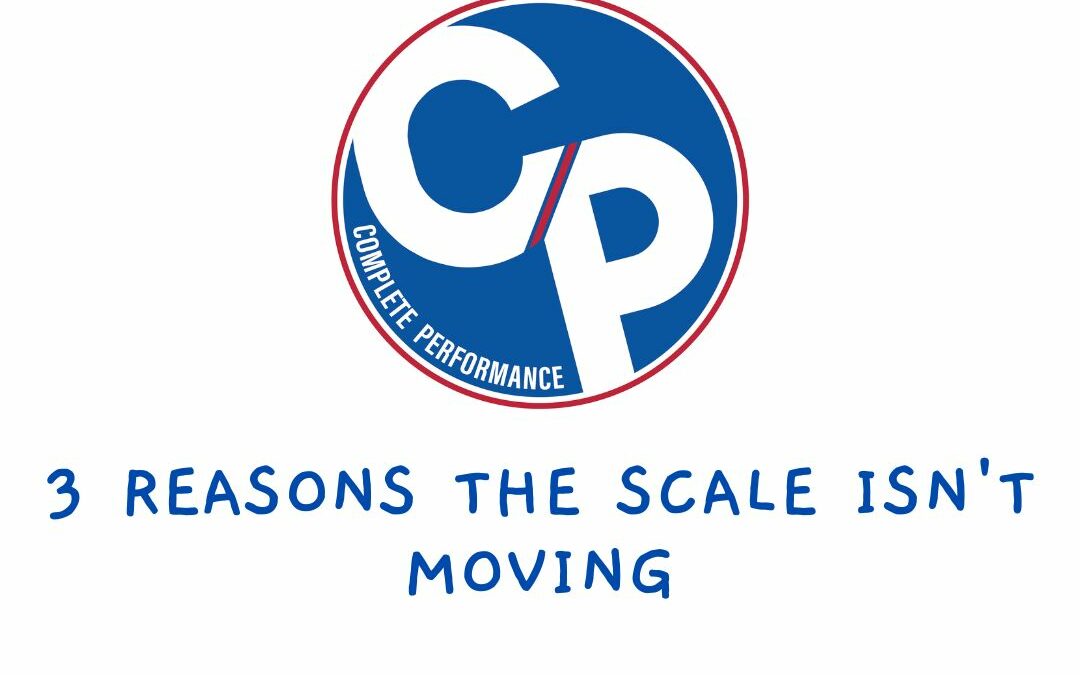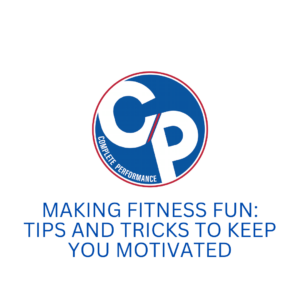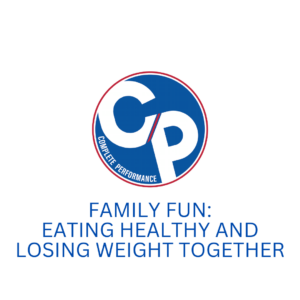What the hell?
You stepped on the scale AGAIN and NOTHING.
It’s the SAME number you saw yesterday and the day before.
Heck, maybe even the week before.
Your workouts have been burners.
You’re eating hasn’t been too bad – maybe a little bit here or there but it can’t be THAT bad!
Maybe you should just eat less?
Add a little cardio?
Or if you’re REALLY frustrated…
QUIT
Look, before you do anything crazy like that, I want to share the 3 reasons the scale is so stuck.
At Complete Performance, we operate under 3 core pillars – Fitness, Fuel & Family.
Funny enough, those are the 3 reasons most don’t consistently find the number on the scale trending downwards.
Let’s start with Fuel.
Fuel
Like you’ve said, your eating has been pretty good!
You’ve made a LOT of changes and are eating WAY better than you once were, so the confusion as to why the scale stopped moving is normal.
Given the popular belief that you just need to eat less, it’s no surprise you’re on the verge of cutting a few more calories to get a little movement.
Before you go slashing calories, I’m here to tell you that the reason you’re not losing weight is because your tracking is off.
🤯
Yes, you’ve done REALLY well, but here’s how your tracking might have been thrown off:
#1 It’s Human Nature to Grow Portion Sizes
We live in a super-sized society, wherein a small American plate is a LARGE in other countries.
When you started, you checked the portion size on the box, measured things out, and weighed your food. You got the hang of it and things were going well…
Then, you got a little hungry…
Thought a little extra would be nice…
So that once perfectly rounded off ½ cup of rice wasn’t so rounded because what will it hurt???
Only your calorie deficit 😉
At Complete Performance, we ask our clients to check in on their portion sizes every 4 to 6 weeks to account for our natural tendency to grow portion sizes.
#2 You’re Missing Snacks, Bites & Nibbles
My grandma was infamous for her little “nibbles.”
And if you are too, this is a perfect reason the scale is stuck…
Tell me if any of this sounds familiar –
You’re feeding the kids and you grab a few bites of french fries, Cheez-its or grapes.
You’re celebrating a birthday or retirement at work and you have just a little of this and a little of that at the office potluck. (On top of your pre-packed lunch because you’re “being good” ya know).
Or you say you’re going to have just a bite or small piece of dessert, then that turns into another because it’s just small, right?
Trust me, those snacks, bites and nibbles really add up.
Think of it this way – each small bite is about 50 to 100 calories.
Take a couple of those and your 500 calorie deficit for the day (what you need to average to lose 1# per week) is all but wiped out.
#3 You’re Eating Out Too Much
Look, I get it…
You’re busy, so on-the-go meals are a must.
You’re social, so you can’t be expected to give up half-price apps, happy hours and dinners out.
And you’re human, so eating out is a way we celebrate and connect with others.
Now, I’m not here to tell you that you CANNOT eat out during fat loss, but there is a fine line…
It’s important to remember that going out to eat means you have ZERO cooking control.
Can you order salads? Lean cuts of meat with veggies? Calorie-friendly meals?
Absolutely.
But the reality is you don’t ACTUALLY know what or how much is there!
Restaurants are cooking for profit, not often for health, so there’s bound to be ingredients, oils and sauces that aren’t super clean or accurately measured.
Let’s also not forget that overall portion sizes are HUGE at most restaurants, so it’s likely it doesn’t completely match up with the calories on the menu nor what you need to maintain your calorie deficit.
It’s no wonder it’s easy for calories to sneak up while out to eat!
FITNESS
At this point, you’ve settled into a decent fitness routine…
You go to the gym, you sweat it out and you get on with your day.
Workout ✅
At this point, you’re feeling 2 things –
1 – Frustrated (If you’re putting in all this blood, sweat and tears why is it not working!)
2 – Tempted (To both abandon ship because this doesn’t work AND add more because you must not be doing enough).
Before we jump into how to alleviate that frustration, let’s touch on that temptation to do more…
You started this with the hope of NOT spending your life in the gym.
You’re a busy employee, mom, partner, friend, etc.
You don’t have time for that!
But it’s what someone else did…
Or it’s what worked for you in the past…
Or it’s what you saw on the internet.
The reason you’re tempted is because it’s easier.
It’s way easier to look at doing more than it is to point out what you might be doing wrong…
But before you start slaving away on the treadmill, take a look at what you CAN do to not be so frustrated, save on your time AND get better results.
#1 You’re Overestimating Activity
If there’s one thing to be true about humans it’s that we LOVE to underestimate how much we eat and overestimate how much we move.
Now, that’s partially due to the inaccuracy of fitness trackers. (Hate to break it to you, but even the most accurate fitness tracker was found to be off by 27% by Stanford University).
Buuuut the majority of that is due to the fact that we love to glorify our efforts when we’re working to establish new habits.
It’s our way of psyching ourselves up to continue on with it.
Which is great, BUT it doesn’t always mean we’re realistic.
In order to best prevent the overestimation of activity, here are 3 tips:
#1 Be intentional about your activity.
Set a specific time each day to get up and move your body.
Our #CPTeam is encouraged to get active for 30 minutes everyday, whether it’s in one bout or broken up is totally up to them.
#2 Track your steps.
At the end of the day, take a look at your fitness tracker to check your step count.
Reflect on it.
Do you need to repeat today or get more tomorrow? How can you make that happen?
Want more information on Step Goals? Check it out HERE!
#3 Challenge yourself.
Don’t just get the workout done, challenge yourself!
Find out how you can work just a little bit harder every workout!
More on this in a minute…
#2 You Forgot Progressive Overload
There are days where getting the workout done is victory in itself (we like to call those “Just Happy to Be Here” Days).
But when that becomes everyday, that’s the reason the scale is stuck.
At that point, you’ve forgotten about Progressive Overload (when you gradually increase the sets, reps, weights, etc to increase the training stimuli).
Progressive overload ensures that your muscles receive a new stimulus, which prevents your body from adapting to training, becoming more efficient and burning fewer and fewer calories in your workout.
With our #CPTeam, here’s how we do it:
- Adjust Set & Rep Schemes Weekly
- Track Workout Metrics & Recommend More Challenging Variations
- Testing Periods (~8-10 weeks) to Assess Training Progress & Next Steps
#3 You Think Your Workout Is Enough
Some might argue this falls under overestimating your efforts, but this is too common of a point amongst the people I talk with to not have its own point.
Losing weight and keeping it off requires a lifestyle; one that’s different from the way you currently live.
Is working out 3 or 4 days per week an improvement?
Without a doubt.
But oftentimes, that’s not going to help you lose weight at a rate that you’re satisfied with, nor will it help you keep it off.
That requires an overall shift to an active lifestyle.
If you’re someone who says “Oh I worked out today!” and then proceeds to sit at a desk for the remainder of the day, you have serious work to do before it’s considered that you live an active lifestyle.
That 45 to 60 minutes of activity is only 1/8th of your day.
It’s recommended that our #CPTeam sets daily activity metrics through things like:
- A Daily Activity Goal
- Step Goals
- The 3×3 Plan
A separate blog can be pieced together around the importance of #3 here, but know that your workout isn’t enough for your results.
Family
Family is 100% about accountability to yourself and to another individual.
You can be crushing it in the fitness and fuel aspects of life, but without Family, the scale will stall out sooner rather than later.
Here’s why:
#1 You’re Lacking Accountability
You might not feel like your portion sizes have increased or that you’re overestimating activity, but lacking in accountability means it’s only time before that happens.
There are 2 must have styles of accountability:
Personal Accountability (Follow through on what you tell yourself you’re going to do)
External Accountability (Someone to hold you to your personal accountability; a coach, mentor, family member, friend, etc).
You need both to keep that scale moving, so here’s how I recommend you maintain your accountability:
- Check in with Yourself Daily
- Check in with Another Weekly
- Check in with Yourself & Another Monthly to Drive the Future Self
#2 It’s Catching Up to You
Do you ever get that feeling that you just need a break from your family?
Like that post-holiday feeling where you’re dreaming of your normal day-to-day life?
Your body does the same thing you know…
After pushing hard in a fat loss phase, your body recognizes what you’re doing – taking parts from the whole, so it does everything possible to protect itself.
You feel tired because you’ve been burning more calories than you’re taking in. The fatigue is your body’s way of pulling you to slow down to protect resources and burn fewer calories.
You feel hungry and tired because you’ve been burning more calories than you’re taking in.
The fatigue is your body’s signal to SLOW DOWN, so it can right the ship (AKA burn fewer calories).
Hunger is another signal to EAT MORE, so it can restock nutrients and get back to “normal.”
They’re both signs that this fat loss phase is catching up to you.
It’s 100% normal, but it’s also 100% likely to slow down the scale progress if it doesn’t get some attention.
Here’s how you can give it the right attention:
- Don’t Diet Forever (Seasonal Dieting is a VERY powerful driver for results)
- Take a Diet Break (Every ~8-12 weeks depending on the individual)
- Be 100% Confident It Fits YOU! (No cookie-cutter programs welcome)
#3 It’s Managing Stress
Another shoutout to that pesky hormone, cortisol (Grab the Cortisol Fact Sheet Here) 🙄
Many forget the impact of stress on fat loss because these days, who ISN’T stressed!?
If stress goes unmanaged, it leads to:
- Poorer Food Selection
- Stressed-Out Binges
- Missed or Lower Quality Workouts
- & a Cortisol Build Up (Most often in the belly where EVERYBODY wants to trim up)
Between work, family and social, you have PLENTY to stress about and cause the scale to stall out.
But do you know what makes that worse?
Stressing about the fact that the scale hasn’t moved.
If you find yourself stressed out, acknowledge that the scale might get a little stuck instead of completely swearing off fat loss.
Take a little extra time for self-care.
Do something you love.
And know that consistency is what leads to results long-term, you’ll get there.
REFERENCES
https://www.wellandgood.com/calorie-counters-on-fitness-trackers/#:~:text=Yet%20these%20estimates%20are%20notoriously,was%20off%20by%2027%20percent.




